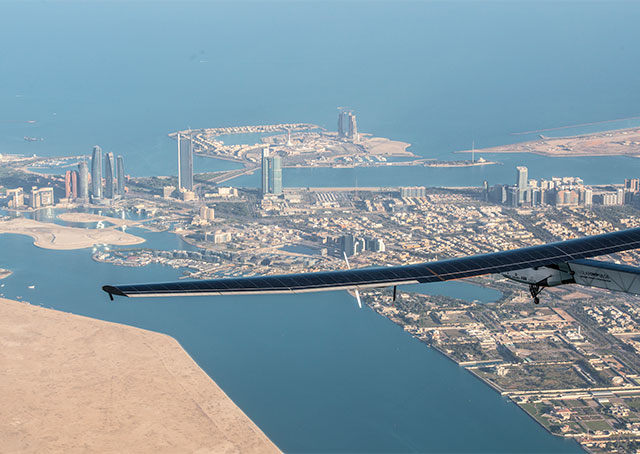Solar Impulse nears departure

As March arrived, Solar Impulse 2 pilots and crew made final preparations and set a new departure date for their round-the-world flight in a fragile aircraft powered by the sun. With flight testing underway and many a watchful eye on weather, March 7 was the earliest possible departure date from Abu Dhabi, the team announced Feb. 27 to a growing social media audience.
Followers around the world will track the progress of Swiss pilots Bertrand Piccard and André Borschberg, who seek to demonstrate the potential of renewable energy as the first to circumnavigate powered only by the sun, on social media and a new website that includes links to videos, photos, and tools to follow the mission’s progress.
“Solar Impulse was not built to carry passengers, but to carry a powerful message. Solar Impulse is a physical testament to the importance of innovation and pioneering spirit,” Piccard said in a recent press release from the team, which has attracted high-profile corporate sponsorship including chocolate-maker Nestlé, which will provide fuel for the pilots themselves: meals custom-engineered for the mission by the Nestlé research team. “It is meant to encourage people to question their old certitudes and habits. It is a powerful symbol of change.”
The pilots will take turns flying legs up to six days long, meditating to help endure the long periods of isolation and dining on prepared meals and snacks developed by Nestlé researchers with their nutritional needs and tastes in mind and packaged to withstand the conditions. The 5,000-pound aircraft with a wingspan of 236 feet needs to be kept clear of turbulence, and the team will need to thread their way between weather threats along a route that will take them east through Asia and across the Pacific Ocean to Hawaii, then continue on to the United States. The mission, expected to return to Abu Dhabi in five months, is the culmination of 12 years of research including test flights in a previous version of the all-solar aircraft which toured the United States in 2013. That celebrated journey laid the groundwork for the updated aircraft, Si2, being test-flown in Abu Dhabi as the team prepared to launch on the first leg east to Muscat International Airport in Oman. In addition to Hawaii, the team plans U.S. stops in Phoenix and New York.
Solar Impulse has already broken ground as the first manned solar aircraft able to fly through the night on battery power, and replenish those batteries as the motors continue to work by day. More than 17,000 solar cells produce that power, a design that has been refined by a small army of engineers, advisors, technological partners, and suppliers. The effort has captured the imagination of many more, including heads of state (Prince Albert II of Monaco is among the project’s champions.) The team has more than 21,600 followers on Twitter, and more than twice that number on Facebook.



